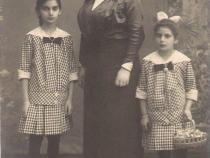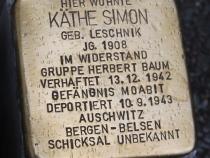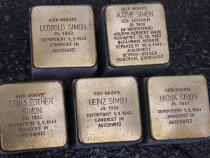Käthe Julie Leschnik was born on 3 March 1908, the youngest daughter of Michaelis and Johanna Leschnik. She had a sister, Irene, who was three years older than her. The girls grew up in a comfortable, middle-class home on Bad Straße in Wedding; their father ran two successful clockmaker’s and jeweller’s shops.
We know little about her childhood and youth. As her father was the chairman of the Ahavar Achim synagogue association we can presume that religion played an important role. From 1915 to 1920, Käthe was a member of a Jewish Wanderbund hiking club. After attending a secondary school for girls, she learned tailoring and worked as a tailor until she married. In March 1931 she married Leopold Simon, a clockmaker. As he was from Czarnków (German: Czarnikau) like her father, it is likely that the two families had known each other for a long time. According to the information her sister gave for the compensation proceedings, Käthe observed traditional Jewish rituals at home. Irene wrote in 1971: “My sister received a dowry from my father Michaelis Leschnik (…) of 10,000 Reichmarks in cash and a trousseau encompassing everything, furniture, linens and other household goods. After marrying, my sister became self-employed and opened her own clockmaker’s and gold items shop with a workshop attached for repairing clocks and watches (…). My sister attended to the customers while her husband saw to any clock repairs that were required.” A shop is first registered under Leopold Simon’s name in the Berlin directory of 1932, at Bülow Straße 11, right on Nollendorfplatz.
In May 1933 Käthe gave birth to her daughter Erika Esther. Half a year later, in October 1933, she had to say goodbye to her big sister Irene and her husband, as they emigrated to Palestine. No doubt the step had been discussed within the family, but Leopold and Käthe obviously decided not to give up their supposedly secure existence in Berlin for a life of uncertainty in an undeveloped and hot country. In October 1935 their son Heinz was born. Käthe Simon and her family had apparently moved the previous year as their gold items shop was now registered under the address Grunewald Straße 63 in Schöneberg. Here, they employed several members of staff. There was an apartment behind the shop where the Simons lived. Despite the Nazis’ anti-Jewish measures, including the boycott of Jewish businesses, the Simons’ shop prospered. This suddenly changed, however, with the November pogrom in 1938. Leopold’s sister-in-law Irene later wrote: “In the Night of Broken Glass, several people broke into the shop from the street. My sister and her family immediately fled the apartment though the window overlooking the courtyard to my parents’ home. The clockmaker’s shop and the adjacent apartment were completely destroyed, and all the valuables looted.” The Simon family moved in with Käthe’s parents in Bad Straße in Wedding. “Neither my brother-in-law nor my sister ever dared go back to the shop or the apartment on Grunewald Straße again,” wrote Irene. Robbed of their means of existence, Käthe and her husband then suffered the loss of Michaelis Leschnik, whose shops had also been wrecked and looted in the November pogrom, and who in his desperation was driven to take his own life in March 1939. Johanna Leschnik, Käthe’s mother, was forced to move into a so-called “Jews’ home” in Wilmersdorf.
The Simons were also forced to vacate the apartment on 15 September 1940 and move to Oranienburger Straße 90, where they were allocated three empty rooms in the courtyard building, let by a Jewish butcher. A friend of Käthe described the quarters as “the smokerooms of a slaughterhouse”. Here, on 11 June 1941, their son Micha was born, named after Käthe’s late father Michaelis Leschnik. But under the Nazis’ name-changing law of August 1938, Jewish parents could no longer freely choose names for their children. Käthe and Leopold were forced to choose from a list of supposedly Jewish names, designed to make children easily identifiable as Jewish, and opted for ‘Mechel’ as this was closest to the name Micha. On the memorial stone that Irene Zimmt had erected after the war for Michaelis Lechnik and his family on the Jewish Cemetery, the name ‘Micha’ appears, not ‘Mechel’.
On 23 January 1942, Käthe and her family suffered another severe blow. Facing imminent deportation, her maternal aunt Erika Weinberg took her own life by an overdose of sleeping pills. Käthe arranged the burial in the Jewish Cemetery in Weißensee. In May 1942 her mother Johanna returned to live on Bad Straße, but this time as a subtenant in a “Jews’ home” close to her old apartment. In early June, Johanna Leschnik received instructions to report to an assembly point. From here she was deported to Sobibor on 13 June and immediately murdered. Käthe most likely knew she would never see her mother again. None of their friends and family who had been deported had ever been heard of or seen again.
We know nothing about the Simons’ views of the situation, which they no doubt discussed. We don’t know whether they approved of the Herbert Baum group’s attack on the Nazis’ propaganda exhibition ‘The Soviet Paradise’, or not. But the crackdown that followed was also to hit them. Käthe Simon had organized a place to hide for the young resistance fighter Felix Heymann, who had been a member of the Herbert Baum group and went underground during the ensuing wave of arrests, in the home of some friends. Like all the other members of the Herbert Baum group, he was later arrested and executed in Plötzensee. “In December 1942 Frau Simon was arrested following a complaint that she had hidden a young resistance fighter. She was remanded in custody until August 1943 in Moabit, where I was permitted to visit her every four weeks,” stated Hedwig Hecht, a schoolfriend of Käthe in the 1950s.
While Käthe was in prison, her husband Leopold had to perform forced labour and leave their three children alone at home. On 27 February 1943, he was arrested during the Nazis’ “factory campaign”, probably at his workplace, and taken to an assembly camp. The three children must have been left to fend for themselves for several days as they were not collected from the apartment until shortly before their deportation. They and their father were deported to Auschwitz on 1 March 1943. But that is not to say that they were together as they travelled to their deaths: Leopold was entered as number 336 on the transport list while the children had the numbers 1839-1841. We do not know if they were crammed into the same cattle truck or whether they were even aware of each other’s presence. As Leopold Simon’s name was not registered at Auschwitz, it is most likely that he, like his children, was murdered in the gas chambers immediately on arrival.
Although an indictment was prepared for Käthe Simon, and dated 25 June 1943, she did not stand trial. Instead, she was taken to the assembly camp on Große Hamburger Straße in August and deported from there to Auschwitz on 10 September 1943. There is no record of what happened to her after that. Her sister Irene is convinced she saw her in 1946 on a photo of the liberation of Bergen-Belsen concentration camp, taken by a member of the British army. A friend of Käthe is also sure that the woman on the photograph is Käthe Simon. If this is the case, she must have been sent on one of the death marches from Auschwitz to Bergen-Belsen. Perhaps she, like many prisoners of the Bergen-Belsen camp, died shortly after liberation as a result of maltreatment during imprisonment or one of the epidemics that raged. We will never know for certain. But not knowing what had become of her children and husband, she would surely have contacted her relatives in Palestine had she survived.
Käthe Julie Simon née Leschnik
Location
Badstraße 44
District
Gesundbrunnen
Stone was laid
07 March 2018
Born
03 March 1908 in
Occupation
Geschäftsfrau
Verhaftet
December 1942 to 24 August 1943
in
Moabit
Deportation
on 10 September 1943
to
Auschwitz
Fate unknown






